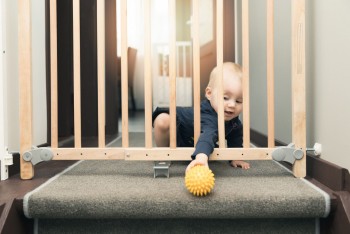Preventing home injuries in the time of COVID-19
By Pamela Fuselli, Dr. Suzanne Beno, and the CPS Injury Prevention Committee
These are challenging times. Parents are working from home, supervising children, and many have become ad hoc teachers as their children are also at home for the foreseeable future. Injuries at home, especially for children, are likely to rise when we are all spending so much time at home. So vigilance while multitasking is tough but key.
Want some good news? Injuries are preventable. Here are some quick tips you can use to reduce the risk of injuries at home.
Children’s developmental stages play a role in determining what’s hazardous. Get down to their level and check out your house from their perspective to see what attracts their attention and could potentially pose a risk. Do this often as your child’s abilities and skills are rapidly changing.
Top tips for kids of all ages:
- Burns: Spilled tea, coffee, soup and hot tap water are the leading causes of burns. Use a cup with a tight-fitting lid, such as a travel cup, for your hot liquid drinks and keep them away from counter edges. Also make sure your stovetop pot handles face toward the wall.
- Drowning: If you have a pool or pond, install a 1.2-metre high, four-sided fence with a self-closing, self-latching gate to prevent children from having dangerous access to water.
- Fire and carbon monoxide: Make sure you have both smoke and carbon monoxide detectors on every level of your home and that they are working properly.
- Play equipment: If you have such equipment in your yard, inspect it now that it that has weathered the winter months to make sure no repairs are needed, or parts need replaced. Is it properly anchored? Is the surfacing deep and soft?
- Poisonings: Store medications, cannabis, alcohol, vaping products, cleaning supplies and other corrosive or poisonous household products (laundry detergent, dish detergent, bleach, pesticides) safely out of sight, out of reach, away from food, and in their original containers, ideally in a locked cabinet.
- Strangulation: Use cordless window coverings, e.g. curtains, blinds. If cords are present, secure them to the wall.
- Trampoline injuries: Trampolines are not recommended for use at home, as jumping on a trampoline is a high-risk activity with the potential for significant injury to children and youth.
Top tips for infants and toddlers:
- Choking: Keep small items out of reach, especially magnets, button batteries, toys/toy parts. If an object fits through a cardboard toilet paper roll, it can cause a young child to choke. Finely chop, puree or cut lengthwise foods such as nuts, popcorn, hog dogs and carrots.
- Drowning: Always stay within sight and reach of your child when they are in the bath. Babies can drown in as little as 2.5 centimetres (1 inch) of water in just a few seconds.
- Falls: Install baby gates at the top and bottom of stairs, making sure to use hardware mount gates at the top. Move cribs away from windows. Be vigilant with babies on change tables and beds.
As much as you likely don’t want to go to a hospital responding to COVID-19 illnesses, don’t delay consulting services such as your primary care doctor, your local poison centre or telehealth, to help guide what you should do in case of an injury. If the injury is serious, go to the closest emergency department or call 911.
As the weather improves, getting outside is really good for your child(ren) – from physical activity to sparking imagination and creativity – but be sure to follow all recommendations from your local authorities with respect to COVID-19 restrictions.
Following these top tips will greatly help your children stay safe and healthy, indoors and out, during this already stressful and difficult time. For more information, check out:
Keep your young child safe around the home, information for parents from the Canadian Paediatric Society
Injury prevention tips from Parachute, Canada’s national injury prevention charity
Injury prevention tips from the Canadian Paediatric Orthopaedic Group
Pamela Fuselli is President and CEO of Parachute, Canada’s national injury prevention charity.
Dr. Suzanne Beno is Chair of the Canadian Paediatric Society’s Injury Prevention Committee and a paediatrician at The Hospital for Sick Children in Toronto.
Copyright
The Canadian Paediatric Society holds copyright on all information we publish on this blog. For complete details, read our Copyright Policy.
Disclaimer
The information on this blog should not be used as a substitute for medical care and advice. The views of blog writers do not necessarily represent the views of the Canadian Paediatric Society.
Last updated: May 12, 2020

